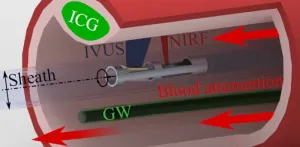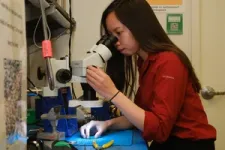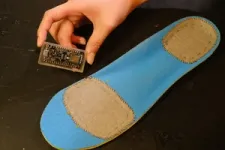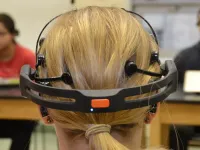(Press-News.org) Cardiovascular diseases (CVDs) or heart diseases are still the leading cause of death globally. Fortunately, doctors are now equipped with more advanced and sophisticated tools that help them diagnose CVDs. A prominent example is intravascular ultrasound (IVUS), which enables cardiologists to obtain images of the inside of blood vessels using a thin ultrasound probe. These images can then be used to assess problems such as the thickening of arteries caused by fat or plaque buildup.
While IVUS is undoubtedly a powerful technique, it fails to capture key information about the pathology of the observed vessels. To address this problem, near-infrared fluorescence (NIRF) imaging is used in conjunction with IVUS for a more thorough examination of the blood vessels. NIRF makes use of fluorescent agents that can outline biological processes inside the body. These agents are injected into the bloodstream, where they bind to specific pathology-related compounds on vessel walls, such as proteins or nucleic acids. The fluorescence signals that are generated are combined with the IVUS images to provide accurate information. However, during NIRF-IVUS measurements, the distance between the NIRF detector and the blood vessel wall keeps changing. This presents a new challenge because blood attenuates the intensity of the fluorescence signals, and the “amount” of blood between the NIRF detector and the vessel wall varies constantly.
Thus, a team of researchers led by Professor Vasilis Ntziachristos from the Technical University of Munich, Germany, came up an innovative solution to this problem. In a new study published in Journal of Biomedical Optics (JBO), the team reported a new technique to measure the fluorescence attenuation of blood using a “guidewire” that moves the NIRF-IVUS probe. “We provide an adaptive correction scheme tailored to each patient and each imaging frame collected during the imaging procedure,” says Ntziachristos.
The idea behind this new method is based on the fact that the guidewire is always visible to the NIRF probe. Coating the guidewire with a known concentration of fluorescent particles ensures that the signal on the guidewire will provide an indirect measure of the blood attenuation in the current image. The distance between the NIRF probe and the guidewire is determined via IVUS, and so is the distance between the NIRF probe and the blood vessel wall. A correction factor for the fluorescence signal measured at the blood vessel wall can be calculated after a simple calibration procedure.
The researchers used a small NIRF-IVUS system reported in their previous study to test their technique in a clinical model. They also performed experiments on capillary phantoms, which simulate the properties of small blood vessels. They recorded a 4.5-fold improvement over uncorrected NIRF signal and <11 percent errors for target signals, which looks quite promising! Moreover, the correction method maintained a mean accuracy of 70 percent in tissue experiments. These values are also in stark contrast to the accuracies obtained by other correction methods, which use average attenuation factors rather than calculating them for each frame and for the precise probe-to-vessel distances measured via IVUS.
The team suggests that it should be relatively easy to directly incorporate their technique into clinical practice, since no major modifications to existing equipment are required. The guidewire can be used as a reference standard for other intravascular fluorescence imaging modalities, as well as other optical methods beyond fluorescence, if appropriate coatings are used.
Professor of Medical Physics at the University of Wisconsin – Madison and JBO Editor-in-Chief Brian Pogue remarks, “This new method for correcting intravascular NIRF signals is simple and accurate and could pave the way for in vivo studies and eventual clinical translation.”
Read the Gold Open Access article by Philipp Rauschendorfer et al., “Accounting for blood attenuation in intravascular near-infrared fluorescence-ultrasound imaging using a fluorophore-coated guidewire,” J. Biomed. Opt. 28(4), 046001 (2023), doi 10.1117/1.JBO.28.4.046001.
END
Improving the accuracy of near-infrared fluorescence in cardiovascular imaging
Fluorescence-coated guidewire aids in the accurate estimation of blood attenuation during intravascular procedures
2023-04-13
ELSE PRESS RELEASES FROM THIS DATE:
New tool to study hepatitis B could open the door to a cure
2023-04-13
Hepatitis C and hepatitis B viruses both attack the liver, eventually causing deadly cirrhosis or cancer. But while antivirals can cure 95 percent of HCV infections, its cousin HBV has long eluded effective therapeutics. As a result, nearly 1 million people die from HBV every year.
Now researchers from the lab of Rockefeller’s Charles M. Rice—who shared the 2020 Nobel Prize in Physiology or Medicine for pioneering novel methods to grow and study HCV—have developed an approach for studying HBV in the lab that ...
Biological bouncers: How immune cells yank antigens from surfaces to learn and evolve
2023-04-13
Most cells evolve slowly, accumulating incremental changes that better suit their environments. Immune cells, because they must adapt rapidly to counter new threats, evolve much more quickly. Part of that, UCLA physicists now report, rests on their ability to forcibly pull antigens off other cells’ surfaces and “study” them.
By using this type of mechanical force, the immune system’s B cells, which create antibodies that fight off harmful pathogens like viruses, bacteria and parasites by targeting their ...
OHSU researchers assemble comprehensive atlas of gene mutations in human tissue
2023-04-13
Researchers have created the largest atlas of post-zygotic genome mutations in healthy human tissue ever assembled — a scientific advancement that could unlock new avenues for diagnosing and treating genetic disease. It is the largest ever in terms of the combined number of tissues and number of donors sampled.
The study, led by researchers at Oregon Health & Science University, published today in the journal Science.
The development points the way toward understanding the genetic underpinnings of disease associated with cancer as well as innumerable conditions caused by cellular malfunction, including ...
In sync brainwaves predict learning, study shows
2023-04-13
Students whose brainwaves are more in sync with their classmates and teacher are likely to learn better than those lacking this “brain-to-brain synchrony,” shows a new study by a team of psychology and education researchers. The findings, which appear in the journal Psychological Science, offer new insights into the learning process.
“This is the first study to show that the extent to which students’ and teachers’ brainwaves are in sync during real-world learning can predict how well students retain information from class,” says lead author Ido Davidesco, an assistant professor at the ...
Researchers discover tiny galaxy with big star power using James Webb telescope
2023-04-13
Using first-of-their-kind observations from the James Webb Space Telescope, a University of Minnesota Twin Cities-led team looked more than 13 billion years into the past to discover a unique, minuscule galaxy that generated new stars at an extremely high rate for its size. The galaxy is one of the smallest ever discovered at this distance—around 500 million years after the Big Bang—and could help astronomers learn more about galaxies that were present shortly after the Universe came into existence.
The paper is published in Science, one of the world's top peer-reviewed academic journals.
The University of Minnesota researchers were one of the first teams to study ...
Humans, and piglets, and bears, oh my! Preventing dangerous blood clots
2023-04-13
“Don’t poke the bear”, they said. But that’s exactly what a team of scientists have been doing, to discover the secrets of blood clotting.
Hibernating bears, paralysed humans, and pigs kept in small enclosures all avoid dangerous blood clots, despite being immobile for extremely long periods.
Research from the University of Reading, with partners in Denmark, Germany, Norway and Sweden, shows that reduction of a key protein prevents the formation of blood clots in all three mammal species when they ...
UTSA astrophysicist leads international team in discovery of new exoplanet outside Earth’s solar system
2023-04-13
(SAN ANTONIO) April 13, 2023 - An international research team led by UTSA Associate Professor of Astrophysics Thayne Currie has made a breakthrough in accelerating the search for new planets.
In a paper slated for publication April 14 in Science, Currie reports the first exoplanet jointly discovered through direct imaging and precision astrometry, a new indirect method that identifies a planet by measuring the position of the star it orbits. Data from the Subaru Telescope in Hawai`i and space telescopes from the European Space Agency (ESA) were integral to the team’s discovery.
An ...
Shift to ‘flash droughts’ as climate warms
2023-04-13
Embargoed: Not for Release Until 19:00 (7.00 pm) British Summer Time, Thursday, 13 April 2023
Shift to ‘flash droughts’ as climate warms
‘Flash droughts’ have become more frequent due to human-caused climate change and this trend is predicted to accelerate in a warmer future, according to research published today [13 April 2023] involving the University of Southampton.
The research published in Science shows that flash droughts, which start and develop rapidly, are becoming ‘the new normal’ for droughts, making forecasting and preparing for their impact more difficult.
Flash ...
First Nations populations at greater risk of severe flu, research finds
2023-04-13
First Nations populations at greater risk of severe flu, research finds
Responsible for over 5 million infections and 100,000 deaths every year, influenza remains one of the most challenging public health issues for populations globally, particularly First Nations communities.
New research from the Peter Doherty Institute for Infection and Immunity (Doherty Institute) has found that First Nations populations around the world are significantly more likely to be hospitalised and die from influenza compared to non-Indigenous populations.
Researchers from the Doherty ...
Channeling mechanical energy in a preferred direction
2023-04-13
A research group led by scientists from the RIKEN Center for Emergent Matter Science have developed a unique material, based on nanofillers embedded in a hydrogel, that can channel mechanical energy in one direction but not the other, acting in a “nonreciprocal” way. With this composite material--which can be constructed at various sizes--the team was able to use vibrational up-and-down movements to make liquid droplets rise within a material against gravity. Using this material could thus make it possible to make use of random vibrations and move matter in a preferred direction.
Channeling energy in a preferred direction is an ...
LAST 30 PRESS RELEASES:
NTP-enhanced lattice oxygen activation in Ce-Co catalysts for low-temperature soot combustion
Synergistic interface engineering in Cu-Zn-Ce catalysts for efficient CO2 hydrogenation to methanol
COVID-19 leaves a lasting mark on the human brain
Scientists use ultrasound to soften and treat cancer tumors without damaging healthy tissue
Community swimming program for Black youth boosts skills, sense of belonging, study finds
Specific depressive symptoms in midlife linked to increased dementia risk
An ‘illuminating’ design sheds light on cholesterol
Who is more likely to get long COVID?
Study showcases resilience and rapid growth of “living rocks”
Naval Research Lab diver earns Office of Naval Research 2025 Sailor of the Year
New Mayo-led study establishes practical definition for rapidly progressive dementia
Fossil fuel industry’s “climate false solutions” reinforce its power and aggravate environmental injustice
Researchers reveal bias in a widely used measure of algorithm performance
Alcohol causes cancer. A study from IOCB Prague confirms damage to DNA and shows how cells defend against it
Hidden viruses in wastewater treatment may shape public health risks, study finds
Unlock the power of nature: how biomass can transform climate mitigation
Biochar reshapes hidden soil microbes that capture carbon dioxide in farmland
Reducing saturated fat intake shows mortality benefit, but only in high-risk individuals
Manta rays create mobile ecosystems, study finds
Study: Mixed results in using lipoic acid to treat progressive multiple sclerosis
Norbert Holtkamp appointed director of Fermi National Accelerator Laboratory
New agentic AI platform accelerates advanced optics design
Biologists discover neurons use physical signals — not electricity — to stabilize communication
Researchers discover that a hormone can access the brain by hitchhiking
University of Oklahoma researcher awarded funding to pursue AI-powered material design
Exploring how the visual system recovers following injury
Support for parents with infants at pediatric check-ups leads to better reading and math skills in elementary school
Kids’ behavioral health is a growing share of family health costs
Day & night: Cancer disrupts the brain’s natural rhythm
COVID-19 vaccination significantly reduces risk to pregnant women and baby
[Press-News.org] Improving the accuracy of near-infrared fluorescence in cardiovascular imagingFluorescence-coated guidewire aids in the accurate estimation of blood attenuation during intravascular procedures






